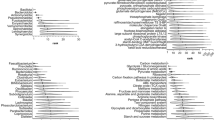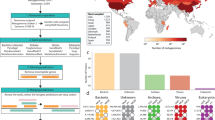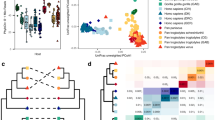Abstract
The human gut contains a dense, complex and diverse microbial community, comprising the gut microbiome. Metagenomics has recently revealed the composition of genes in the gut microbiome, but provides no direct information about which genes are expressed or functioning. Therefore, our goal was to develop a novel approach to directly identify microbial proteins in fecal samples to gain information about the genes expressed and about key microbial functions in the human gut. We used a non-targeted, shotgun mass spectrometry-based whole community proteomics, or metaproteomics, approach for the first deep proteome measurements of thousands of proteins in human fecal samples, thus demonstrating this approach on the most complex sample type to date. The resulting metaproteomes had a skewed distribution relative to the metagenome, with more proteins for translation, energy production and carbohydrate metabolism when compared to what was earlier predicted from metagenomics. Human proteins, including antimicrobial peptides, were also identified, providing a non-targeted glimpse of the host response to the microbiota. Several unknown proteins represented previously undescribed microbial pathways or host immune responses, revealing a novel complex interplay between the human host and its associated microbes.
Similar content being viewed by others
Log in or create a free account to read this content
Gain free access to this article, as well as selected content from this journal and more on nature.com
or
References
Apajalahti JH, Särkilahti LK, Mäki BR, Heikkinen JP, Nurminen PH, Holben WE . (1998). Effective recovery of bacterial DNA and percent-guanine-plus-cytosine-based analysis of community structure in the gastrointestinal tract of broiler chickens. Appl Environ Microbiol 64: 4084–4088.
Ayala-Castro C, Saini A, Outten FW . (2008). Fe–S cluster assembly pathways in bacteria. Microb Mol Biol Rev 72: 110–125.
Bäckhead F, Ley RE, Sonnenburg JL, Peterson DA, Gordon JI . (2005). Host–bacterial mutualism in the human intestine. Science 307: 1915–1920.
Chang HJ, Sheu SY, Lo SJ . (1999). Expression of foreign antigens on the surface of Escherichia coli by fusion to the outer membrane protein traT. J Biomed Sci 6: 64–70.
Denef VJ, Shah MB, VerBerkmoes NC, Hettich RL, Banfield JF . (2007). Implications of strain- and species-level sequence divergence for community and isolate shotgun proteomic analysis. J Proteome Res 6: 3152–3161.
Derensy-Dron D, Krzewinski F, Brassart C, Bouquelet S . (1999). β-1,3-Galactosyl-N-acetylhexosamine phosphorylase from Bifidobacterium bifidum DSM 20082: characterization, partial purification and relation to mucin degradation. Biotechnol Appl Biochem 29: 3–10.
Dicksved J, Halfvarson J, Rosenquist M, Järnerot G, Tysk C, Apajalahti J et al. (2008). Molecular analysis of the gut microbiota of identical twins with Crohn's disease. ISME J 2: 716–727.
Drake HL, Gössner AS, Daniel SL . (2008). Old acetogens, new light. Ann NY Acad Sci 1125: 100–128.
Eckburg PB, Bik EM, Bernstein CN, Purdom E, Dethlefsen L, Sargent M et al. (2005). Diversity of the human intestinal microbial flora. Science 308: 1635–1638.
Eng JK, McCormack AL, Yates III JR . (1994). An approach to correlate tandem mass spectral data of peptides with amino acid sequences in a protein database. J Am Mass Spectrom 5: 976–989.
Florens L, Carozza MJ, Swanson SK, Fournier M, Coleman MK, Workman JL et al. (2006). Analyzing chromatin remodeling complexes using shotgun proteomics and normalized spectral abundance factors. Methods 40: 303–311.
Gill SR, Pop M, Deboy RT, Eckburg PB, Turnbaugh PJ, Samuel BS et al. (2006). Metagenomic analysis of the human distal gut microbiome. Science 312: 1355–1359.
Havemann GD, Bobik TA . (2003). Protein content of polyhedral organelles involved in coenzyme B12-dependent degradation of 1,2-propanediol in Salmonella enterica serovar Typhimurium LT2. J Bacteriol 185: 5086–5095.
Jaroszewski L, Rychlewski L, Li Z, Li W, Godzik A . (2005). FFAS03: a server for profile–profile sequence alignments (Web Server Issue). Nucleic Acids Res 33: W284–W288.
Jernberg C, Löfmark S, Edlund C, Jansson JK . (2007). Long-term ecological impacts of antibiotic administration on the human intestinal microbiota. ISME J 1: 56–66.
Klaassens ES, de Vos WM, Vaughan EE . (2007). Metaproteomics approach to study the functionality of the microbiota in the human infant gastrointestinal tract. Appl Environ Microbiol 73: 1388–1392.
Kurokawa K, Itoh T, Kuwahara T, Oshima K, Toh H, Toyoda A et al. (2007). Comparative metagenomics revealed commonly enriched gene sets in human gut microbiomes. DNA Res 14: 169–181.
Ley RE, Turnbaugh PJ, Klein S, Gordon JI . (2006). Human gut microbes linked to obesity. Nature 444: 1022–1023.
Ligtenberg AJ, Veerman EC, Nieuw Amerongen AV, Mollenhauer J . (2007). Salivary agglutinin/glycoprotein-340/DMBT1: a single molecule with variable composition and with different functions in infection, inflammation and cancer. Biol Chem 12: 1275–1289.
Lo I, Denef VJ, Verberkmoes NC, Shah MB, Goltsman D, DiBartolo G et al. (2007). Strain-resolved community proteomics reveals recombining genomes of acidophilic bacteria. Nature 446: 537–541.
Lu P, Vogel C, Wang R, Yao X, Marcotte EM . (2007). Absolute protein expression profiling estimates the relative contributions of transcriptional and translational regulation. Nat Biotechnol 25: 117–123.
Markert S, Arndt C, Felbeck H, Becher D, Sievert SM, Hügler M et al. (2007). Physiological proteomics of the uncultured endosymbiont of Riftia pachyptila. Science 315: 247–250.
McDonald WH, Ohi R, Miyamoto DT, Mitchison TJ, Yates III JR . (2002). Comparison of three directly coupled HPLC MS/MS strategies for identification of proteins from complex mixtures: single-dimension LC-MS/MS, 2-phase MudPIT, and 3-phase MudPIT. Int J Mass Spectrom 219: 245–251.
Mukhopadhyay A, Redding AM, Joachimiak MP, Arkin AP, Borglin SE, Dehal PS et al. (2007). Cell-wide responses to low-oxygen exposure in Desulfovibrio vulgaris Hildenborough. J Bacteriol 189: 5996–6010.
Nishimoto M, Kitaoka M . (2007). Identification of N-acetylhexosamine 1-kinase in the complete lacto-N-biose I/galacto-N-biose metabolic pathway in Bifidobacterium longum. Appl Environ Microbiol 73: 6444–6449.
Peng J, Elias JE, Thoreen CC, Licklider LJ, Gygi SP . (2003). Evaluation of multidimensional chromatography coupled with tandem mass spectrometry (LC/LC-MS/MS) for large-scale protein analysis: the yeast proteome. J Proteome Res 2: 43–50.
Peterson DA, Frank DN, Pace NR, Gordon JI . (2008). Metagenomic approaches for defining the pathogenesis of inflammatory bowel disease. Cell Host Microbe 3: 417–427.
Ram RJ, Verberkmoes NC, Thelen MP, Tyson GW, Baker BJ, Blake II RC et al. (2005). Community proteomics identifies key activities in a natural microbial biofilm. Science 308: 1915–1920.
Rosenstiel P, Sina C, End C, Renner M, Lyer S, Till A et al. (2007). Regulation of DMBT1 via NOD2 and TLR4 in intestinal epithelial cells modulates bacterial recognition and invasion. J Immunol 15: 8203–8211.
Saint N, El Hamel C, De E, Molle G . (2000). Ion channel formation by N-terminal domain: a common feature of OprFs of Pseudomonas and OmpA of Escherichia coli. FEMS Microbiol Lett 190: 261–265.
Tabb DL, McDonald WH, Yates III JR . (2002). DTASelect and contrast: tools for assembling and comparing protein identifications from shotgun proteomics. J Proteome Res 1: 21–26.
Wilmes P, Andersson AF, Lefsrud MG, Wexler M, Shah M, Zhang B et al. (2008). Community proteogenomics highlights strain-variant microbial protein expression within activated sludge performing enhanced biological phosphorus removal. ISME J 2: 853–864.
Zybailov B, Mosley AL, Sardiu ME, Coleman MK, Florens L, Washburn MP . (2006). Statistical analysis of membrane proteome expression changes in Saccharomyces cerevisiae. J Proteome Res 5: 2339–2347.
Acknowledgements
We thank Dr David Tabb and the Yates Proteomics Laboratory at Scripps Research Institute for DTASelect/Contrast software, the Institute for Systems Biology for proteome bioinformatics tools used in the analysis of the MS data, and M Land of the ORNL Genome Analysis and System Modeling Group for computational resources for proteomic analysis. We thank Patricia Carey (ORNL) for computational assistance with proteome informatics. Becky R Maggard (ORNL) is thanked for secretarial assistance in the preparation of this paper. The ORNL part of this research was sponsored in part by US Department of Energy under contract DE-AC05-00OR22725 with Oak Ridge National Laboratory, managed and operated by UT-Battelle, LLC. The SLU research was sponsored by the SLU Faculty for Natural Resources and Landscape Management, by the MICPROF grant funded by Uppsala Bio-X (www.uppsalabio.se/) and in part by US Department of Energy contract DE-AC02-05CH11231 with Lawrence Berkeley National Laboratory. The Burnham Institute for Medical Research (BIMR) was sponsored in part by the NIH Grant P20 GM076221. The human sampling was sponsored by Örebro University Hospital Research Foundation and the Örebro County Research Foundation. Alison L Russell was funded by the Genome Science and Technology Program at the University of Tennessee and by Oak Ridge National Laboratory.
Author information
Authors and Affiliations
Corresponding author
Additional information
Supplementary Information accompanies the paper on The ISME Journal website (http://www.nature.com/ismej)
Rights and permissions
About this article
Cite this article
Verberkmoes, N., Russell, A., Shah, M. et al. Shotgun metaproteomics of the human distal gut microbiota. ISME J 3, 179–189 (2009). https://doi.org/10.1038/ismej.2008.108
Received:
Revised:
Accepted:
Published:
Issue date:
DOI: https://doi.org/10.1038/ismej.2008.108
Keywords
This article is cited by
-
Novel Techniques and Models for Studying the Role of the Gut Microbiota in Drug Metabolism
European Journal of Drug Metabolism and Pharmacokinetics (2023)
-
Ecosystem-specific microbiota and microbiome databases in the era of big data
Environmental Microbiome (2022)
-
Using high-abundance proteins as guides for fast and effective peptide/protein identification from human gut metaproteomic data
Microbiome (2021)
-
Combining proteogenomics and metaproteomics for deep taxonomic and functional characterization of microbiomes from a non-sequenced host
npj Biofilms and Microbiomes (2020)
-
Metaproteomics characterizes human gut microbiome function in colorectal cancer
npj Biofilms and Microbiomes (2020)



